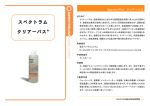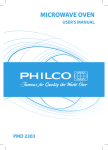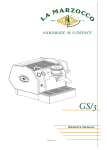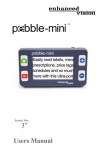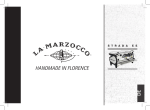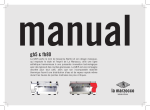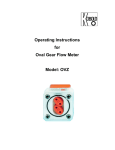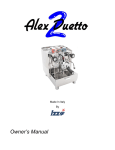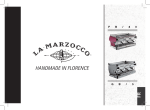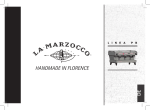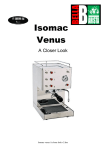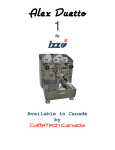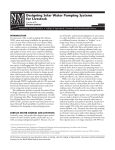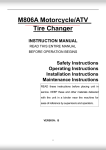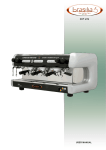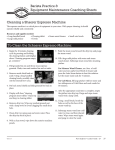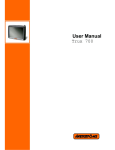Download La Marzocco FB/80 User Manual
Transcript
HANDMADE IN FLORENCE HANDMADE IN FLORENCE GB/5 FB/80 Operating Manual available Also available in UL - NSF version Ver. 1.3 La Marzocco s.r.l. Via Bolognese 68 Pian Di San Bartolo 50010 Firenze, Italy t: +39.055.401.390 f: +39.055.401.349 e-mail: [email protected] www.lamarzocco.com GB/5 - FB/80 English Table of Contents Chapters 1. General Warnings and Safety Specifications pag 2 2. Definition of Available Models pag 3 3. Installation pag 5 4. Operating the Espresso Machine and Preparing Coffee pag 7 5. Preparing Other Hot Drinks pag 9 6. Preventative Maintenance and Weekly Cleaning pag 10 7. De-Commissioning and Demolition pag 11 8. History and Use of the “La Marzocco” Coffee Machines pag 12 www.lamarzocco.com Operators Manual - ENG - V 1.3.pmd 1 V1.3 30/10/2006, 14.34 1. General Warnings and Safety Specifications 1) English 2) 3) This operating manual is an integral and essential part of the product and must be supplied to users. Users are asked to read the enclosed warnings and cautions carefully, as they provide valuable information concerning safety during installation, operation and maintenance. This manual must be kept in a safe place and be available for consultation to new and experienced users alike. Ensure product’s integrity by inspecting the packaging, making sure it presents no signs of damage which might have affected the enclosed machine. Packaging (boxes, plastic bags, foam parts and whatever else) must not be left around within easy reach of children, due to the potential danger it represents, nor be discarded in the environment. 5) Check to see that data on the rating plate corresponds to those of the main electrical supply which the machine will be hooked up to. 6) The installation must be performed according to local electrical and plumbing codes and regulations. The installation also must comply to the manufacturer’s instructions, and must be performed by qualified and authorized personnel. 7) 8) 9) The manufacturer shall not be held responsible for any damages caused by improper and/or irrational use. 12) Using any electrical device requires that certain fundamental rules be observed. In particular: - do not touch the device with wet or humid hands and feet; - do not use the device while having no shoes on your feet; - do not use extension cords in bath or shower rooms; - do not unplug the device from the power outlet by pulling on the power Check the machine’s integrity after having carefully removed the packaging. Note: In case of doubt, do not go on any further and contact your dealer or retailer immediately. They will send out specialized personnel authorized to perform service on the espresso machine. 4) 11) This device must be used exclusively for the functions it has been designed and built for. Any other application is inappropriate and dangerous. Incorrect installation may cause for injury/damages to people, animals or objects, for which the manufacturer shall not be held responsible. Safe electrical operation of this device will be achieved only when the connection to the power outlet has been completed correctly and in observance of all local, national, and international electrical codes and safety regulations, and particularly by grounding the unit. Make sure grounding has been done properly as it represents a fundamental safety requirement. Ensure qualified personnel check such connection. Furthermore, you must ensure that the capacity of the available electrical system is suitable for the maximum power consumption indicated on the espresso machine. supply cable; - do not expose the device to atmospheric agents (rain, sun, etc.); - do not allow children or untrained people to use this device. 13) Before carrying out any maintenance and/or cleaning operations, turn the main switch, which is located on the front left of the machine, to the “0” or OFF position, and disconnect the machine from the electrical network by unplugging the cord or by switching off the relative circuit breaker. For any cleaning operation, follow exclusively the instructions contained in this manual. 14) In case the machine is operating in a faulty manner or breaks down, disconnect it from the electrical network (as described in the preceding point) and close the water supply valve. Do not attempt to repair it. Contact a qualified and authorized professional to perform any repair. Any repairs must be performed exclusively by the manufacturer or by an authorized centre using only original parts. Non compliance with the above could compromise the safe operation of the machine. 15) You should plan to make use of an omnipolar connector during installation, as required by local, national, and international electrical codes and regulations. 16) In order to avoid dangerous overheating problems, it is recommended that the power supply cable be fully unfurled. 17) Do not obstruct air intake and exhaust grilles and, in particular, do not cover the cup warmer tray with cloths or other items. 18) The machine’s power supply cable must not be replaced by users. In case the power supply cable becomes damaged, shut off the machine and disconnect the machine from the electctrical network by switching off the relative circuit breaker and close off the water supply; to replace the power supply cord, contact qualified professionals exclusively. 10) We do not recommend using adapters, multiple plugs and/ or extension cords. If you cannot avoid using them, make sure that they are exclusively of the kind which conforms to local, national, and international electrical codes and safety regulations, being careful not to exceed the power and current ratings indicated on such adapters and extension cords. 2 Operators Manual - ENG - V 1.3.pmd 2 V1.3 La Marzocco, S.r.l. 30/10/2006, 14.34 Firenze, Italia GB/5 - FB/80 2. Definition of Available Models This operating manual refers exclusively to the following models, of our own manufacture: GB/5 or FB/80, Model EE & AV into 2, 3 and 4 groups C B GB/5 A 2 gr. A [mm] C 3 gr. 4 gr. FB/80 B [mm] B 475 475 485 627 627 627 750 1190 950 955 755 WEIGHT [kg] 485 622 622 622 C [mm] A 475 485 90 100 1195 130 13 12 EE 6 5 2 3 AV 9 1 8 4 7 10 8 9 11 Fig. 1 - Model AV & EE with 2, 3, or 4 groups Legend 1) Main Switch 2) Pressure Gauge (Steam Water) 3) Pressure Gauge (Brew Water) 4) Brew Groups 5) Control Panel 6) Group #1 Keypad 7) Digital Display 8) Steam Wand 9) Steam Knob www.lamarzocco.com Operators Manual - ENG - V 1.3.pmd 3 10) 11) 12) 13) Hot Water dispense nozzle Removable Drain Tray Manual Brew Switch (EE model) Hot Water Switch ( EE model) For additional information on electronics, keypads, and software programming, please see the section entitled Software Programming your Espresso Machine. V1.3 3 30/10/2006, 14.34 English 1) Common Dimensions, Weights, and Features 2. Definition of Available Models 2) General Description The machine is built in 2, 3, and 4 group versions and is essentially composed of the following parts: English 1) 2) 3) 4) 5) Steam Boiler (produces steam and hot water) Coffee (“saturation”) boiler Brewing groups Exterior Cover Water pump 3) Description of the various parts • Steam Boiler The Steam Boiler consists of a cylindrical tank, of varying length according to the number of coffee groups, which is made of AISI 300 series stainless steel. Each unit is subjected to a hydraulic test, at a pressure of 6 bar, and has an operating pressure of 1.3-1.5 bar. The following is a list of effective volumes and power ratings according to the number of groups installed: 2 groups 3 groups 4 groups 7.0 liters 11 liters 14,5 liters • Exterior Cover It consists of a stainless sheet steel body for the GB/5 and painted plastic for FB/80. The structure has been the object of specific studies to provide good aesthetics, to lower ergonometric costs for the operator and to reduce the chance of damage to a minimum. • Water Pump The water pump, is a differential pressure, “positivedisplacement” type installed on the water supply tubing and is set-up to operate anytime the coffee groups are activated, and through an electric level gauge whenever the steam boiler needs to be replenished. The Coffee Boiler and Steam Boiler contain water at elevated temperature. Water temperature over 125゚F / 52゚C can cause severe burns instantly or death from scalding. (Coffee Boiler 200゚F / 93.3゚C- Steam Boiler 260゚F / 127゚C) 2000 or 3000 Watts 3000 or 4000 Watts 3000/3800 or 5000 Watts Covers are installed at either end of the cylindrical tank and on one of them there is a housing for the water heating element, which allows the steam boiler to operating pressure within approximate 25 minutes. Operating pressure is maintained by a pressure switch or a temperature probe. The steam boiler has various fittings used for safety devices, for supplying hot water and steam,, and for the heating element. • Coffee Boiler The Coffee Boiler consists of a cylindrical tank, of varying length according to the number of coffee groups, which is made of AISI 300 series stainless steel. Each unit is subjected to a hydraulic test, at a pressure of 18 bar, and has an operating pressure of 9 bar. The following, table is a list of effective volumes and power ratings according to the number of groups installed: 2 groups 3 groups 4 groups 3.4 liters 5.0 liters 3.4 + 3.4 liters (2 Boilers Installed) 1400 Watts 1600 or 1900 Watts 1400 + 1400 Watts Covers are installed at either end of the cylindrical tank and on one of them there is a housing for the water heating elements. The temperature of the coffee boiler is maintained by an electronic temperature controller (PID capable) with an accuracy of 0.2°C. The brewing groups are installed on the boiler. • Brewing Groups They consist of a precision casting made of stainless steel. The brewing group accepts the portafilter used to hold the ground coffee; the espresso flows through the brewing group, through the portafilter basket, through the portafilter spout, and into the cup(s) after the brewing button has been pressed. 4 Operators Manual - ENG - V 1.3.pmd 4 V1.3 La Marzocco, S.r.l. 30/10/2006, 14.34 Firenze, Italia GB/5 - FB/80 English 3. Installation Power Supply Cord Electrical Supply Connection Waste/Drain Water Pump Motor Power Cord Water Filtration/Softener Water Pump and Motor Expansion Valve Drain Grate Drain Tray Drain Hose Connection Water Supply Connection www.lamarzocco.com Operators Manual - ENG - V 1.3.pmd 5 V1.3 5 30/10/2006, 14.34 3. Installation English 1) Accessories pump is operating, otherwise air can be introduced into the brew boiler causing an undesireable condition. Check the package to make sure that the following accessories are included: • a number of 1-dose and 2-dose portafilters corresponding to the number of groups; • replacement 1-dose and 2-dose filters (one of each) • 1 tamper • 1 blind filter • cleaning detergent, for the groups • 3 stainless steel braided hoses for water connections • 1,5 mt of reinforced plastic tubing for drainage • 1 hose clamp 3) Electrical Connections a) Power Supply Cord Before making any electrical connections make sure that the 2 strain relief connectors are firmly secured to the body of the machine in order to prevent inadvertent stress on the power cables. In order to proceed with installation, it is necessary that the following are available: a) Pipes carrying drinking water with a 3/8"G (BSP) end connection; (3/8" Compression for USA and Canada) b) Electrical Supply according to the specification of the espresso machine purchased: • Single/Three phase 220VAC - 50/60 Hz electrical connection with ground, protected socket and approved interlock switch • Single phase 200VAC - 50/60 Hz electrical connection with ground, protected socket and approved interlock switch • Three-phase, 380VAC - 50/60 Hz electrical connection with neutral + ground, near the bench on which the machine is installed and terminating in a suitable protected fivepole socket equipped with an approved interlock switch This is the main power supply cable that provides power to the entire espresso machine. There are different types of cable based upon the electrical requirements of the espresso machine purchased • 200/220VAC 1 Phase 3-core cable with 2.5/4/6/10mm2 cross section or AWG 12/10/8 (for UL version), secured to espresso machine via a strain relief connector • 220VAC 3 Phase 4-core cable with 4 mm2 cross section for versions with 1, 2 , 3 and 4 groups secured to espresso machine via a strain relief connector • 380 VAC 3 Phase 5-core cable with 2.5/6 mm2 cross section for versions with 1, 2, 3 and 4 groups secured to espresso machine via a strain relief connector b) Water Pump Motor Power Cord This is the power supply for the water pump motor. The internal electronics will switch the pump motor on when needed. • 3-core cable with 1.5 mm2 cross section or 3-core AWG 16 (for UL version) secured to espresso machine via a strain relief connector c) Waste water drain system NOTE: The drinking water stopcock and the terminal switches for the electrical system need to be located in the most convenient position for the operator to access them easily and quickly. 3) Waste Water Drain Connection The espresso machine drain is to be connected by means of the included reinforced plastic tubing. Connect one end of the reinforced plastic tubing to the drain hose connection on the left side of the espresso machine, secure with included hose 2) Water Supply Connection Connect the inlet of the water filter/softener to the drinking water supply using one of the supplied stainless steel braided hoses. Before connecting the water pump to the espresso machine, flush the water supply line and the filtration system in order to eliminate any residual particles which could otherwise get stuck in taps or valves thus preventing them from working properly. Connect the water supply connection of the espresso machine to the water pump outlet using one of the supplied stainless steel braided hoses. Then connect the water pump inlet to the water filter/softener outlet. NOTE: The water pump is differential pressure, volumetric pump and has been designed to be used exclusively with cold water. Make sure that water is always present while the The manufacturer declines any responsibility for any event leading to liability suits whenever GROUNDING has NOT BEEN COMPLETED according to current local, national, and international regulations and electrical codes, or other electrical parts have been connected improperly. — U.S.A. and Canada Only — Do Not Connect To A Circuit Operating At More Than 150 V To Ground clamp. Connect the other end to a suitable waste water collection system. In case such a system is not available, drained liquids may be collected in a suitable bucket and any necessary drain pipe extensions shall be made using steellined PVC tubing and suitable hose clamps. HAZARDOUS VOLTAGE DISCONNECT FROM POWER SUPPLY BEFORE SERVICING 6 Operators Manual - ENG - V 1.3.pmd 6 V1.3 La Marzocco, S.r.l. 30/10/2006, 14.34 Firenze, Italia 4. Operating the Espresso Machine and Preparing Coffee 1) Starting the Espresso Machine a) Filling the Boilers with Water Once the installation procedures have been completed, it is necessary to fill the boiler tanks with water. Complete the following procedure to properly fill the boiler tanks: • Coffee Boiler The water flows inside the coffee boiler directly, as soon as the water system and water filter/softener taps are opened. Since the inflow of water will compress the air in the boiler it will be necessary to remove or “bleed” the air from the coffee boiler. All air must be removed in order to completely “saturate” the coffee boiler/group assemblies. To remove the air from the boiler, “bleed the groups”, it will be necessary to remove the cup tray from the top of the machine. First remove the cup tray grates from the top of the machine exposing the cup tray. Remove the screws securing the cup tray and then remove. Once removed the top of the groups will be exposed. 2)Waiting for the Espresso Machine to Heat to Operating Temperature During this time, it may happen that the pointer of the coffee boiler pressure gauge reaches as high as 14-15 bar. This may happen anytime that the heating element is in the on condition. In this case it is necessary to adjust the expansion valve (Fig. 3) in such a way that the pressure may never exceed 11-12 bar. In normal operating conditions, the coffee boiler pressure gauge can read anywhere from 0-12 bar. When brewing, the pressure should be set to 9 bar. When the steam boiler reaches operating temperature, the light on the Tea dispense button will light. EE AV When the espresso machine is ready to operate all lights on the keypads will light. EE AV 3)Installing the Portafilters Install the portafilter(s) by inserting them into the group and rotate the handle from left to right. When the portafilters are inserted properly, you can press any of brew buttons to start the Loosen the bleed screws one at a time (see picture above) to allow air to escape until water flows from below the screw head. Tighten the screw to stop the water from flowing. Over tightening can cause damage to the sealing washer and the group cover. Repeat this procedure for all groups. Once all air is removed from the coffee boiler, reinstall the cup tray by following the removal instructions in reverse. • Steam Boiler Turn the main switch (item 1 in Fig. 1) to position “1” or ON, the automatic steam boiler level gauge will be switched on, activating the auto-fill solenoid valve and the motor pump. This will fill the steam boiler to a predetermined level and will shut off when full. Note: It may happen that the air inside the steam boiler builds up pressure (which may be detected through the pressure gauge - item 2, fig. 1) when the water is allowed to flow in; this “false” pressure must be eliminated by opening the steam valves (item 9, Fig. 1). b)Turning the Espresso Machine On Once you have completed these procedures, check the display. The message “Coffee Boiler Filled?” should be displayed. Press enter to confirm that the preceding procedures are complete. The installation is now complete and the espresso machine should be heating to the operating temperatures. www.lamarzocco.com Operators Manual - ENG - V 1.3.pmd 7 Portafilter Basket Portafilter Portafilter Spout flow of water through the portafilter. You should allow hot water to pass through the portafilter(s) for a few seconds each time, in order to pre-heat the portafilter. Note: It is important to leave the portafilters installed in the espresso machine when not in use. The portafilter must remain heated for the brew process to function correctly. 4)Brewing Coffee It is now possible to remove one of the portafilters to make an espresso beverage. Place some ground coffee in the filter itself: 1 dose (approximately 6 g) for the small filter, 2 doses (2 approximately 10-14 g) for the larger filter. Press down on the ground coffee with the supplied tamper and install the filter holder up again to the bottom of the group and then press a button to begin the brewing process. Note: Some barista believe it is important to press the brewing button prior to installing the portafilter to flush any remaining coffee oils and particles from the group. Some also flush just after brewing to do the same. Please experiment to make the best possible procedure for your coffee. V1.3 7 30/10/2006, 14.34 English GB/5 - FB/80 4. Operating the Espresso Machine and Preparing Coffee English 1)Controlling the Brew Process Using Volumetric Programming. This espresso machine allows the volumetric programming of each of the first 4 buttons on each group (numbered left to right). Please consult the Software Programming Manual for further instructions. 2) General Notes for Coffee Preparation The potafilters must remain heated since they are at the lowest position of the group itself, and they are partially isolated from the same due to the rubber gasket between them. This can be accomplished by leaving the portafilters installed in the machine when not in use. The portafilters may also be actively heated. This procedure may be carried out by activating one of the brew buttons to flush hot water through the portafilter then turning off the water flow. Do not remove the portafilter when its relative group is brewing hot liquids. The Coffee Boiler contains water at elevated temperature. Water temperature over 125゚F / 52゚ C can cause severe burns instantly or death from scalding. It is important to remember that coffee left over in the filters must be removed only when you need to prepare another cup, and only at that time should you place a new dose of ground coffee in the filter. The size of the coffee granules is extremely important in preparing a good cup of coffee, other than the type of coffee mix used, quite obviously. The ideal grinding can be determined by making various coffees using the amount of ground coffee that you would normally use for each cup (we recommend at least 6g). The best grinding is that which allows coffee to flow out from the filter holder spouts neither too slowly, drop by drop, nor too quickly. A general rule is that a double dose should dispense approximately 2 fluid oz. of espresso in approximately 25 seconds. IMPORTANT To improve the flavor profile of the espresso, the temperature of the water in the coffee boiler, and therefore of the groups, may eventually be raised or lowered via the digital display (please consult the Software Programming Manual for detailed instructions). 8 Operators Manual - ENG - V 1.3.pmd 8 V1.3 La Marzocco, S.r.l. 30/10/2006, 14.34 Firenze, Italia GB/5 - FB/80 5. Preparing Other Hot Drinks English 1) Steaming Milk or Other Liquids Dip one of the 2 steam wands (part 8, fig. 1) which are connected to the steam valve, into the liquid to be heated, turn the steam knob (part 9, fig. 1) gradually until steam comes out at the end of the wand. The steam will transfer heat to the liquid raising its temperature up to boiling point. Be careful not to allow liquid to overflow in order to avoid severe burns. In order to prepare milk for making cappuccino with the right amount of foam, go through the following steps: • Place the container half-full of milk under the steam wand, open the steam valve and bring the temperature of the milk almost up to 149/158° F 65/70° C. • Lower the container so as to bring the wand end to a point just below the surface of the milk; at this point, move the container up and down just enough to dip the nozzle end in and out of the milk until you get the right amount of foam. You can then pour this milk into a cup containing warm espresso and you will end up with a fresh cup of cappuccino. In order to prevent the heated liquid from being sucked back into the steam boiler it is recommended that you purge the steam valve and steam wand by opening the valve for a few seconds to allow steam to escape to the atmosphere from the end of the steam wand. Failure to do so can cause the heated liquid to transfer from the heated liquid container to the steam boiler (via vacuum created from cooling parts). This condition is undesireable and can cause contamination in the steam boiler. 2) Preparing Tea and Other hot Drinks. You may dispense hot water by using the fixed nozzle (item 10 fig 1). To dispense hot water, press the tea water button on the right most group. AV EE This button commands the hot water delivery. The volume of water delivered may be adjusted via the display (see the Software Programming Manual for further instructions). The temperature of the water dispensed may be adjusted by adjusting the mixing valve under the right side cover of the espresso machine. www.lamarzocco.com Operators Manual - ENG - V 1.3.pmd 9 V1.3 9 30/10/2006, 14.34 6. Preventative Maintenance and Weekly Cleaning 6) Cleaning the Diffuser Screen Due to filter holder discharge operations (subsequent to coffee brewing), a certain amount of coffee grounds may slowly build- The machine must not be dipped in, nor splashed with, water in order to clean it. For cleaning operations, please follow the instructions listed below very carefully. English 1) Cleaning groups and drain wells - Put a tablespoon of detergent powder for coffee machines into the blind filter, supplied with the machine, and tighten it onto the group you want to clean by using a normal filter holder. Group Assembly Do not remove the portafilter when its relative group is brewing hot liquids. The Coffee Boiler contains water at elevated temperature. Water temperature over 125゚F / 52゚ C can cause severe burns instantly or death from scalding. Diffuser Screen Diffuser Screw - Activate the automating rinsing (backflushing) routine (see the Software Programming Manual for more detailed instructions) - Rinse the group using a normal filter, by running hot water through it several times. 2) Cleaning filters and filter holders - Put 2 or 3 teaspoons of detergent powder for coffee machines in about 1/2 a litre of water inside a heat-resistant container and boil. - Dip filters and filter holders in the boiled solution and leave them fully submerged for about 30 minutes. - Rinse thoroughly with clean water and run hot water through one group several times with the filters in place. - Make one cup of coffee and discard in order to remove any unpleasant flavor. 3) Cleaning the drain collector Remove the drain tray grill at least twice a week and clean, pull out the water drain collector and clean it thoroughly. Inspect and clean the drain well also, and remove any leftover grounds. 4) Cleaning the body Wipe the stainless steel surfaces with a soft, non abrasive cloth in the direction of the glazing marks, if any. Do not use any alcohol or solvents whatsoever on painted or imprinted parts in order not to damage them. 5) Cleaning the hot water and steam nozzles Steam nozzles must be cleaned immediately after use with a damp cloth and by producing a short burst of steam so as to prevent the formation of deposits inside the nozzles themselves, which may alter the flavor of other drinks to be heated. Hot water nozzles must be cleaned periodically with a damp cloth. 10 Operators Manual - ENG - V 1.3.pmd 10 up on and obstruct, even partially, the diffuser screen. To clean it, you must first remove it by unscrewing the diffuser screw. Put 2 or 3 teaspoons of cleaning detergent for coffee machines in about 1/2 a litre of water inside a heat-resistant container and boil. Place the diffuser screen(s) and diffuser screw(s) in the solution and leave them fully submerged for about 30 minutes. Rinse thoroughly with clean water. Install and run hot water through each group several times with the screen installed. 7) Water Pump Whenever you are brewing coffee, and you can adjust the pump pressure by turning the by-pass screw (below the plug located on the side to which the pump power supply is connected) clockwise to increase and counter-clockwise to reduce pressure. Adjust pressure only when at least one group is brewing coffee. Note: When the heating element in the coffee boiler is energized, the water will expand increasing the start-up pressure. Once the maximum pressure is reached, the expansion (safety) valve should start working by discharging a few drops of water, in order to prevent such pressure from exceeding 11-12 bar. In case the pressure exceeds 12 bar, you must adjust the expansion valve by unscrewing the cap slightly. If this is not sufficient, remove the valve and clear away any calcium deposits. This remedy is valid also in case the valve remains open in the drain position (i.e. the pressure cannot increase to 8 bar approx.). 8) Water Filter/Softener Please see the documentation that accompanied the water filter/softener for the proper operating and cleaning instructions. V1.3 La Marzocco, S.r.l. 30/10/2006, 14.34 Firenze, Italia GB/5 - FB/80 7. De-Commissioning and Demolition 1) De-Commissioning and Demolition English Start by setting the main switch to the “0” or OFF position. Disconnecting from the power outlet Disconnect the espresso machine from the electrical network by switching off the associated circuit breaker or circuit protection device. Remove the power supply cord from the power connection. Remove the Pump Motor Power Cord from the water pump motor. Disconnecting from the water system Shut off the water supply by closing the specific tap located upstream of the water filter/softener inlet. Disconnect the water pipe at the water filter/softener inlet. Remove the hose connecting the espresso machine to the water pump. Remove the reinforced plastic tubing on the drain connection. At this point, the machine may be removed from the bar, being very careful not to drop it or squash your fingers. The machine is made out of various materials and therefore, if you do not intend to put it back in service, it must be taken to a special disposal company which will select the materials which can be recycled and discard the others. Current regulations make it illegal to discard such machine by leaving it on public grounds or on any private property. Recycling notice: Warning for the protection of the environment. Old electrical equipment is made of valuable materials, it is not normal domestic waste! We kindly ask that our clients to contribute to the protection of the environment and natural resources by delivering this equipment to the relevant recycling centers, if they such centers are available in their country. www.lamarzocco.com Operators Manual - ENG - V 1.3.pmd 11 V1.3 11 30/10/2006, 14.34 8. History and Use of the “La Marzocco” Coffee Machines English La Marzocco has been producing espresso coffee machines for use in cafés since 1927. In February of 1939, when machines being manufactured were exclusively of the vertical boiler type, “La Marzocco” designed and built the first horizontal boiler machines, for which it obtained a “patent”. The Second World War brought an end to production of coffee machines, and the fact that La Marzocco was a company of just the right size (small-medium) allowed it to keep in touch directly with its clients and specialty “cafés”, which meant being able to get more accurate feedback information, concerning the needs of the final consumer and market trends, which could then be put into practice. Throughout time, various machines have been designed and built: of the type operating on “Water/Steam” and on the principle of “Hydrocompression”, and of the lever operated, air and steam type; semi-automatic and automatic, with mechanical and electrical actuators, up until current production which consists of machines allowing continuous “brewing” operation. PECULIAR CHARACTERISTICS OF LA MARZOCCO COFFEE MACHINES The great majority of the espresso coffee machines being built today, of almost any brand, are of the “continuous brewing” type, whose basic concept is to use the same water in the tubing, directly to brew coffee by increasing its pressure mechanically and heating it in advance. This has eliminated a particular problem encountered with older machines, which made use of water from the boiler, consisting of the “overheating” of the brewing groups which, at times of heavy workload, would give coffee a particularly unpleasant burned taste. In any case, a good cup of coffee is the result of 4 highly interdependent components, to such extent that if only one of them is not quite in perfect harmony with the others, the resulting cup of coffee will turn out not quite as pleasant in taste. The 4 basic components are: 1. 2. 3. 4. coffee bean mix; water; coffee grinder; espresso machine. 1) Coffee Mix Independent of the various qualities of coffee that make it up, the type of toasting, etc., the freshness of the coffee beans and the way they are preserved is very important. For coffee beans to be used on espresso machines, it’s a good rule of thumb to wait at least 8-10 days after toasting, so that the beans may re-absorb part of the humidity they lost during the toasting process itself, and to use coffee beans within 3-4 days of opening their container. 2) Water Within the limits imposed by the type supplied locally, water should be free of bad savours and “softened” using a suitable water softener in order to avoid calcium build-up; in any case, hardness should not exceed 3-5 grains. If water tastes like chlorine it is recommended that you use an actived carbon filter. 3) Coffee Grinder It must allow you to grind coffee beans in a wide variety of granule sizes, in the most uniform manner possible and once 12 Operators Manual - ENG - V 1.3.pmd 12 you have established the amount of ground coffee required for each cup, the grinder must guarantee a constant amount from dose to dose. It is best to grind coffee from time to time, trying not to leave any ground coffee in the grinder overnight and during days off. 4) Espresso Machine Among other things, the espresso machine must guarantee the following qualities: a) the most appropriate water temperature for the type of coffee mix used, constant in time so as to ensure that a good cup of coffee may be prepared any time, whether you have to make several, one after the other, or one from time to time. b) a constant water pressure through the brewing group and the coffee mix. As far as the quality b) is concerned, it is usually obtained by means of the same system in all the “continuous brewing” type machines, that is by using a positive-displacement motor pump, while quality a) can be obtained with various systems. The great majority of manufacturers uses systems which are very similar to one another. The underlying principle is to heat up the water used for brewing coffee, which comes directly from the pipes and is pushed by the motor pump, by running it through coils or cartridges (small containers) which are located in the boiler. It follows that the latter must be quite large, which entails a noticeable power consumption, and the temperature may be controlled exclusively through a pressure switch, a device which is specifically designed for controlling pressure and not temperature; indeed, the temperature changes every time the water/steam ratio in the boiler changes, and even more so when the latter is replenished with cold water. It is quite obvious that the coils or cartridges which supply water to the brewing groups are very sensible to the above changes. Furthermore, the heat exchange between the main boiler and the coil varies greatly when, as time goes on, conduction of heat is reduced due to calcium deposits forming on the inside and outside of coils or cartridges. In light of the above, and to avoid wastage of electric energy required to keep large quantities of water at operating temperature/pressure, when only a small part is utilized, our machines have been designed with 2 small boilers, of the size which is most suited to the kind of services they have to offer. One of them, a “STEAM GENERATOR”, is used to deliver steam and hot water for various drinks while the other, a “HOT WATER GENERATOR”, is used for the coffee. The latter, therefore, produces hot water used exclusively for brewing coffee, which will flow out, every time the specific group is activated, thanks to the force of the cold water (actually produced by the positivedisplacement pump). The temperature of such water is controlled by an electronic temperature controller and a temperature probe. This system is extremely sensitive and has an accuracy of 0.2 C, electronically adjustable to 1/10 of a degree in order to adapt it to the optimal temperature, depending on the type of coffee mix being used. The brewing groups, work like thermal “flywheels”. They are welded directly to the coffee boiler and are thus an integral part of the boiler itself. The boiler assembly is shaped in such a way that each group is located at a greater height than the boiler, so that, just like in the elements of a thermosiphon, a natural circulation of hot water takes place within each group, at the same temperature of the boiler and kept constant by the electronic temperature control system described previously. The use of these small boilers, completely independent from one V1.3 La Marzocco, S.r.l. 30/10/2006, 14.34 Firenze, Italia 8. History and Use of the “La Marzocco” Coffee Machines another, the special manifold and fastening system of the groups to the boiler as well as the electronic temperature control, have allowed us to: 1) achieve an excellent thermal equilibrium between the brewing groups, both at times of discontinuous operation and during peak times; 2) be able to control the temperature of the water running through the brewing groups, independently of the “pressure” and the level in the small steam boiler, and therefore to optimize the water temperature itself in order to obtain the best possible coffee with whatever coffee mixes are available commercially; 3) save on electrical energy by more than 30%, in many cases, when compared to other machines. The “GB/5” series machines are produced in the 2, 3 and 4 group versions. CONTROL SYSTEMS AND SAFETY DEVICES BUILT INTO “LA MARZOCCO” COFFEE MACHINES All models are equipped with: - automatic level regulator; - automatic pressure regulator; - automatic temperature regulator; - safety devices spring operated safety valve; manual reset thermostats. In all models, coffee is brewed by opening a solenoid valve, one for each group. For the “EE” model, the quantity of coffee brewed is regulated manually by the operator through a switch, while in the “AV” model the quantity is regulated automatically in 4 different doses, which may be programmed at will for each brewing group. This last model is equipped with control panels, one located above each group, with 4 buttons which may be programmed in such a way that by pressing the 1st button you get 1 regular coffee, pressing the 2nd one you get one weak coffee (tall), pressing the 3rd you get 2 regular coffees and by pressing the 4th one you get 2 weak coffees. The fifth button, which has a spiral sign, allows continuous brewing operation which can be interrupted by pressing the very same button again. -Hydraulic test at 18 bar performed on the ready-to-use small boilers, at our factory; 2) Description of the Steam Boiler (C.V.) Composed of AISI 300 series stainless steel tube. Heating is accomplished through an immersion-type plated heating element. -Operating pressure of 1.3-1.5 bar, controlled automatically through a pressure switch or a temperature probe, adjusted so as to open the heating element supply circuit at 1.5 bar and close it at 1.3 bar. -The pressure is displayed by means of a pressure gauge with a scale of 0 to 2 bar. -Safety device, based on an expansion type mechanical valve, with counter-acting spring adjusted to 1.8 bar. -Testing: a) hydraulic test at 4.5 bar performed on the ready-to-use small boilers, at our factory; Capacity and Power Ratings 1) C.C. - 2 groups - 3 groups - 4 groups 3.4 litres 5.0 litres 2x3.4 litres 2) C.V. - 2 groups 7 litres - 3 groups 11 litres - 4 groups 14.5 litres 1400 Watts 1600 or 1900-(HI-Power) Watts 2x1400 Watts 2000 or 3000-(HI-Power) Watts 3000 or 4000-(HI-Power) Watts 3000/3800 or 5000-(HI-Power)Watts CONSTRUCTION DETAILS They consist essentially of 2 small boilers, of which: 1) Coffee Boiler (hot water generator for brewing coffee) 2) Steam Boiler (steam generator for producing steam and hot water for making tea and other hot drinks) 1) Description of the Coffee Boiler (C.C.) Composed of an AISI 300 series stainless steel tube. Heating is accomplished through an immersion-type plated heating element. -Operating temperature 95°C (adjustable), controlled automatically by an electronic temperature controller with an accuracy of 0.2 °C. Operating pressure of 9 bar, developed mechanically by a special positive-displacement pump which is activated automatically every time coffee is brewed. -Pressure is displayed through a pressure gauge with a scale from 0 to 15 bar. -Safety device, based on an expansion type mechanical valve, with counter-acting spring adjusted to 12 bar. -Testing: www.lamarzocco.com Operators Manual - ENG - V 1.3.pmd 13 V1.3 13 30/10/2006, 14.34 English GB/5 - FB/80 HANDMADE IN FLORENCE HANDMADE IN FLORENCE GB/5 FB/80 Operating Manual available Also available in UL - NSF version Ver. 1.3 La Marzocco s.r.l. Via Bolognese 68 Pian Di San Bartolo 50010 Firenze, Italy t: +39.055.401.390 f: +39.055.401.349 e-mail: [email protected] www.lamarzocco.com















